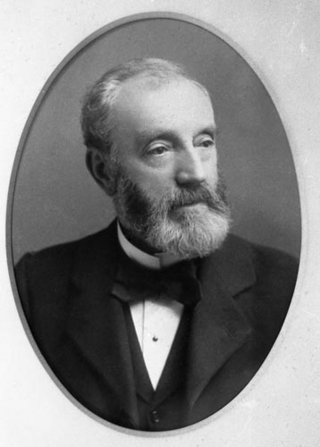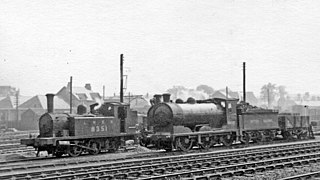
Samuel Waite Johnson was an English railway engineer, and was Chief Mechanical Engineer (CME) of the Midland Railway from 1873 to 1903. He was born in Bramley, Yorkshire and educated at Leeds Grammar School.

The NBR C Class is a class of 0-6-0 steam locomotives designed by Matthew Holmes for freight work on the North British Railway (NBR). They were introduced in 1888 with inside cylinders and Stephenson valve gear. A total of 168 locomotives was built, of which 123 came into British Railways ownership at nationalisation in 1948. This was the last class of steam engine in service in Scotland.

The NBR K Class is a class of 4-4-0 steam locomotive of the North British Railway. The first batch was designed by Matthew Holmes in 1902 and had 6-foot-6-inch (1.981 m) driving wheels for express passenger work. Three more batches were designed by William P. Reid with 6-foot-0-inch (1.829 m) driving wheels for mixed traffic work. This included perishable goods, such as fish from Mallaig and Aberdeen. They had inside cylinders and Stephenson valve gear. The D34 locomotives, commonly known as Glen Class, were built with superheaters. The LNER later fitted superheaters to all D26, D32, and D33 engines as well. All engines of the K class are sometimes known as Glen Class, although the designation is strictly reserved to the fourth (D34) batch.

Dugald Drummond was a Scottish steam locomotive engineer. He had a career with the North British Railway, LB&SCR, Caledonian Railway and London and South Western Railway. He was the older brother of the engineer Peter Drummond, who often followed Dugald's ideas in his own work.
Wilson Worsdell was an English locomotive engineer who was locomotive superintendent of the North Eastern Railway from 1890 to 1910. He was the younger brother of T.W. Worsdell. Wilson was born at Monks Coppenhall, near Crewe on 7 September 1850 to Nathaniel and Mary Worsdell; he was their tenth child and fourth son. In 1860 he was sent as a boarder to Ackworth, a Quaker school in Yorkshire.

Stephen Dewar Holden was a British engineer, the son of the engineer James Holden and succeeded his father as locomotive superintendent of the Great Eastern Railway in 1908, a post he held until his retirement in 1912.
William Paton Reid, CBE was apprenticed to the Cowlairs railway works of the North British Railway in 1879 and was Locomotive Superintendent from 1903 to 1919. He was appointed a CBE in 1920. He was born, and died, in Glasgow, Scotland.
Walter Chalmers was a British engineer. He followed his father into the North British Railway, starting as an apprentice at Cowlairs railway works. In 1904 he became Chief Draughtsman and, from 1920 to 1922, he was Chief Mechanical Engineer.
Thomas Wheatley (1821–1883) was an English mechanical engineer who worked for several British railway companies and rose to become a Locomotive Superintendent at the London and North Western Railway (LNWR) and the North British Railway (NBR).
The North British Railway was opened in 1846 as the line from Edinburgh to Berwick-upon-Tweed, and its workshops were initially situated in St. Margarets, Edinburgh. Gradually other railways were acquired, including in 1865 the Edinburgh and Glasgow Railway, whose works at Cowlairs, Glasgow were better than that at St. Margarets, which were reduced to repairs only and all production moved to Cowlairs.

The NBR Class M was a class of 4-4-0 steam locomotive of the North British Railway. The class was created during the tenures of William P. Reid and Walter Chalmers by rebuilding three earlier types, the "574", "633", and "729", which had all been designed by Matthew Holmes, and shared many features in common. A total of 48 were produced.

The NBR J Class , commonly known as the Scott class, were a class of 4-4-0 steam tender locomotives designed by William P. Reid for the North British Railway. They passed to the London and North Eastern Railway at the grouping in 1923. Forty-three were built, of which thirty-five survived into British Railways ownership in 1948.

The NBR S Class was a class of 0-6-0 steam locomotive designed by William Paton Reid for freight work on the North British Railway. The engines were initially designated as B class, being a development of the standard B class locomotives designed by Reid some eight years previously, and represented the culmination of a long evolution on the NBR of powerful 0-6-0 freight engines. The new locomotives were introduced in 1914 and had superheaters, inside cylinders and piston valves operated by Stephenson valve gear.

The NBR B Class is a class of 0-6-0 steam locomotive designed by William Paton Reid for freight work on the North British Railway. They were introduced in 1906 and had inside cylinders and Stephenson valve gear. The first eighteen locomotives had piston valves and the remainder had slide valves.

The NBR D Class was a class of 0-6-0 tank locomotives designed by Matthew Holmes for short distance freight, station pilot, and heavy shunting duties on the North British Railway.
The NBR 141 Class consisted of two steam 2-4-0 locomotives built by the North British Railway (NBR) in 1869. They were the direct antecedents of the NBR 224 Class 4-4-0.

The North British Atlantic, later known as NBR Class H, and then as LNER Class C11 was a class of 4-4-2 steam locomotive of the North British Railway. The class was designed by William P. Reid, Locomotive Superintendent of the NBR, and entered service under his direction. They were the heaviest, longest, and most powerful locomotives ever employed on the North British Railway.

The NBR Class N was a class of 4-4-0 steam locomotive of the North British Railway. The class was designed by Matthew Holmes and later rebuilt by Holmes's successor, Reid. A total of 12 were produced.
The NBR Class D was a class of 0-6-0 steam locomotive of the North British Railway, often known as the Wee Drummonds. The class was designed by Dugald Drummond. A total of 101 were produced.

The NBR F Class was a class of 0-6-0 tank locomotives, designed by William P. Reid on the North British Railway. They were used for dockyard shunting duties.













